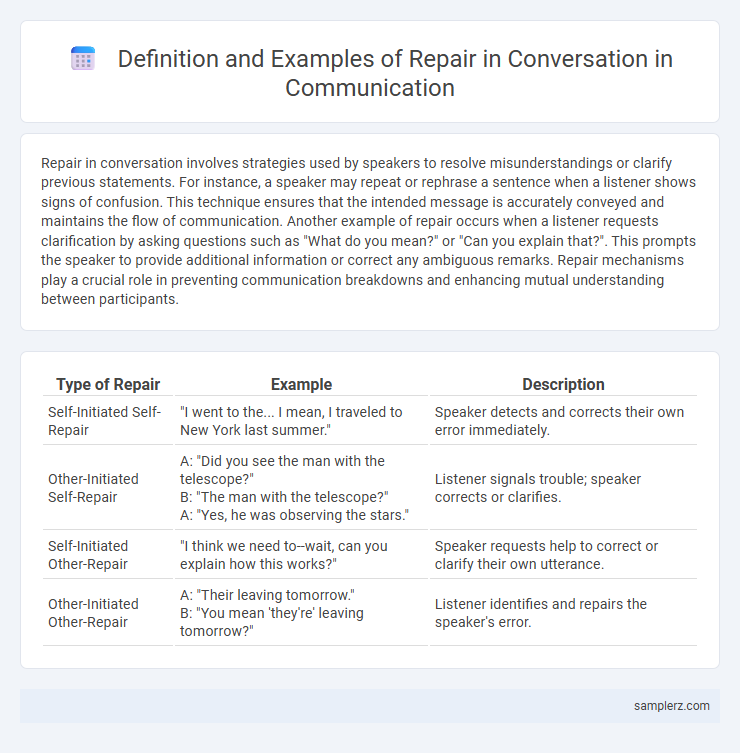Repair in conversation involves strategies used by speakers to resolve misunderstandings or clarify previous statements. For instance, a speaker may repeat or rephrase a sentence when a listener shows signs of confusion. This technique ensures that the intended message is accurately conveyed and maintains the flow of communication. Another example of repair occurs when a listener requests clarification by asking questions such as "What do you mean?" or "Can you explain that?". This prompts the speaker to provide additional information or correct any ambiguous remarks. Repair mechanisms play a crucial role in preventing communication breakdowns and enhancing mutual understanding between participants.
Table of Comparison
| Type of Repair | Example | Description |
|---|---|---|
| Self-Initiated Self-Repair | "I went to the... I mean, I traveled to New York last summer." | Speaker detects and corrects their own error immediately. |
| Other-Initiated Self-Repair |
A: "Did you see the man with the telescope?" B: "The man with the telescope?" A: "Yes, he was observing the stars." |
Listener signals trouble; speaker corrects or clarifies. |
| Self-Initiated Other-Repair | "I think we need to--wait, can you explain how this works?" | Speaker requests help to correct or clarify their own utterance. |
| Other-Initiated Other-Repair |
A: "Their leaving tomorrow." B: "You mean 'they're' leaving tomorrow?" |
Listener identifies and repairs the speaker's error. |
Introduction to Repair in Conversation
Repair in conversation involves strategies speakers use to address and resolve communication breakdowns, such as self-initiated repair where a speaker corrects their own error immediately after it occurs. An example includes a person saying, "I went to the store--no, I mean the mall--yesterday," which clarifies the intended message and prevents misunderstanding. This process enhances conversational coherence and ensures mutual understanding between participants.
Types of Conversational Repair
Conversational repair includes self-initiated repairs, where speakers detect and correct their own errors, and other-initiated repairs, which occur when listeners signal misunderstandings through requests for clarification or repetition. Types of repair also encompass replacement repairs, where incorrect words are substituted with accurate ones, and insertion repairs, involving added information to enhance clarity. Effective conversational repair mechanisms maintain mutual understanding and coherence in communication exchanges.
Self-Initiated Self-Repair Examples
Self-initiated self-repair occurs when a speaker detects and corrects their own speech error to maintain clarity, such as saying, "I will meet you on Friday--no, I mean Thursday." This type of repair enhances conversational flow and prevents misunderstandings by allowing immediate correction without listener intervention. Frequent use of self-initiated self-repairs demonstrates active monitoring and adjustment within natural dialogue.
Other-Initiated Other-Repair Scenarios
In other-initiated other-repair scenarios, a listener explicitly signals trouble by asking for clarification or repetition, such as saying "What did you mean by that?" or "Can you repeat that part?". This method ensures mutual understanding by prompting the speaker to restate or elaborate on the ambiguous message. Effective use of these repair strategies enhances conversational coherence and minimizes misunderstandings in communication.
Clarification Requests in Dialogues
Clarification requests in dialogues function as repair mechanisms by prompting speakers to restate or elaborate on ambiguous or misunderstood utterances, ensuring accurate interpretation. For example, when one participant asks, "Could you explain what you mean by 'effective communication'?" they signal a need for clearer information, preventing miscommunication. These requests enhance conversational coherence and support mutual understanding by addressing potential breakdowns promptly.
Phonetic and Lexical Repair Illustrations
Phonetic repair in conversation occurs when a speaker corrects their pronunciation or sound production, such as repeating "I saw a /kaet/--sorry, I mean a /kaet/"--to clarify the intended word. Lexical repair happens when a speaker adjusts word choice to better convey meaning or correct errors, for example, "I went to the park--no, the playground--yesterday." Both types of repair ensure clearer communication by addressing misunderstandings related to sounds and vocabulary within interactions.
Repair Strategies for Misunderstandings
Repair strategies for misunderstandings in conversation include clarification requests, where one speaker asks for repetition or rephrasing to ensure accurate comprehension. Self-repair involves the speaker detecting and correcting their own speech errors or ambiguous statements in real-time. Another effective method is other-initiated repair, where the listener signals a problem, prompting the speaker to modify or elaborate their message for clearer communication.
Role of Repair in Effective Communication
Repair in conversation plays a crucial role in resolving misunderstandings and maintaining clarity between speakers. Techniques such as self-repair, where a speaker corrects their own speech, and other-repair, where a listener prompts clarification, help prevent communication breakdowns. Effective use of repair mechanisms enhances mutual understanding, supports conversational flow, and strengthens interpersonal relationships.
Repair in Multilingual Interactions
Repair in multilingual interactions often involves code-switching or language clarification to resolve misunderstandings and ensure mutual comprehension. Speakers may repeat phrases in a different language or use simplified vocabulary to facilitate communication across language barriers. These strategies help maintain conversational flow and prevent breakdowns in dialogue between multilingual participants.
Impact of Repair on Conversational Flow
Repair in conversation, such as self-correction or clarification requests, plays a crucial role in maintaining and improving conversational flow by preventing misunderstandings and ensuring mutual comprehension. Effective repair strategies enhance speaker alignment and coherence, reducing communication breakdowns and promoting smoother interaction. The impact of repair is evident in its ability to sustain engagement, facilitate error correction, and contribute to more meaningful and productive exchanges.

example of repair in conversation Infographic
 samplerz.com
samplerz.com